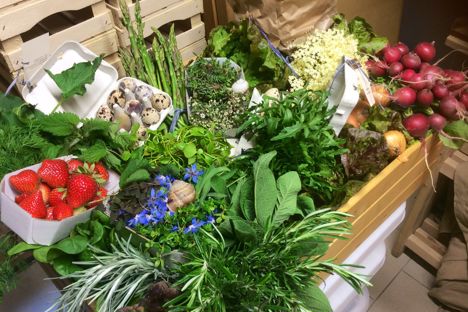
Pine and pasta: cooking the food of South Tyrol
Felicity Spector heads to the Italian region of South Tyrol, a place rapidly earning an international reputation for world-class cuisine, to cook with chef Egon Heiss and discover some of the local specialities.
Pine and pasta: cooking the food of South Tyrol
Felicity Spector heads to the Italian region of South Tyrol, a place rapidly earning an international reputation for world-class cuisine, to cook with chef Egon Heiss and discover some of the local specialities.
‘Put it straight at the back of your mouth. Don’t swallow – just let it melt.’ In front of us, a cauldron of liquid nitrogen swirled clouds of frozen mist into the air. I shut my eyes, took a breath, and popped the vividly green nugget into my mouth. It burned briefly with extreme cold, then suddenly flooded my senses with pine, before the sweetness of corn, just for a moment – and then it was gone. This was my first taste of Michelin-starred popcorn, born from the forests of South Tyrol and created by the culinary mind of Egon Heiss. I was there to attend a cooking lesson with the acclaimed chef.
Before the lesson, however, we would need to fetch some supplies. We stopped off a few miles down the mountain at Afingsbruckhof, where farmer Robert Thurner showed us cheerily around rows of fruit and vegetables, zig-zagging up the steep slopes. We stopped to taste tiny wild strawberries, pick cloudy froths of elderflower and admire stalks of gooseberries, while a bevy of quail rushed dizzily around their run. We left carrying a huge box of produce so vividly fresh that the colours popped, the ingredients plucked from the soil just minutes ago.
We arrived at Egon’s restaurant Bad Schörgau and were shown into the kitchen, which was remarkably calm just a few hours before dinner service. He has trained around the world, including some of London’s best restaurants; he worked with Marco Pierre White, Anton Mossiman and – what he admits was his ‘hardest ever experience’ – Gordon Ramsay’s eponymous three-star establishment in Chelsea.
But his own restaurant (which now boasts a Michelin star of its own) does not try to impress by piling plates with foie gras and truffle. Instead, everything comes from Robert’s farm and the forest that surrounds it in the craggy heights of the Dolomites, where Italy meets Austria and the air is so clear it practically sings. His signature ingredient is pine.
Local bites
After the spectacular start of that flash-frozen pine popcorn – a mixture of sweetcorn purée and pine gel whipped by a siphon gun into the liquid nitrogen – we watched Egon prepare a more traditional Italian dish, risotto. But this one was flavoured with more of that pine, and a spray of what he described as ‘bacon essence’. He spooned out portions onto a plate for us to taste: the flavours were deep and unmistakeable. We moved on to pasta, and the local speciality known as Schlutzkrapfen – tiny ravioli traditionally filled with spinach and ricotta. These were raised to another level with wild garlic and nettles, and the pasta was rolled impossibly thin. ‘This is about the filling,’ Egon told us. ‘I just want you to taste the greens – there is just a hint of ricotta and the most delicate pasta, just to hold it together.’ Somewhat clumsily, we helped to pipe out the filling and gently pinch together the half-moon shapes. After a couple of minutes in boiling water and a drizzle of brown butter, we tucked in. Utterly delicious.
Next, a master class in cooking the perfect egg. From the box we’d picked up at the farm, chef Egon carefully weighed a couple of hen eggs so he could calculate the exact cooking time. ‘Five minutes, ten seconds,’ he said, setting a timer. In another pan, he blended a deep green spinach cream sauce. When the timer went off he carefully peeled the egg – no easy task with such a soft boil – before breadcrumbing it and deep-frying for exactly forty seconds. The yolk spilled out perfectly as we tucked in, merging with a sauce in a glorious richness that was cut through by the crunch of the fried crumb.
We were put to work again, carefully peeling asparagus, double-podding peas and plucking garlic flowers and tiny salad leaves with tweezers while Egon took out a piece of sous vide beef and briefly seared it in a pan. A fried quail’s egg was cut into a perfect circle, then dressed with a dash of olive oil and some parmesan crumb. The perfect spring salad.
Sweet dreams
Felicity Spector
After all of this there was dessert. On the worktop sat a large tray of apple strudel, looking hearty and rustic. But we weren’t about to be offered a slice with whipped cream. Instead, a young sous chef pressed out tiny transparent packets made from edible potato starch, containing a few nuggets of what looked like granola. These were then presented to us inside a hollow wooden apple, and we were told to put them in our mouths and let them dissolve. Somehow they tasted exactly like apple strudel. Amazing.
By now the kitchen was getting busy as sous chefs and commis began prepping for dinner, but chef Heiss looked like he was enjoying himself as he whipped up a batch of Kaiserschmarrn – a traditional Austrian-style pancake that comes ripped up into pieces, studded with dried fruit or compote. This was unlike any other version of the dish you’ll come across elsewhere, and Egon told us his recipe came about by mistake. ‘I had to cook hundreds of portions for brunch and I’d run out of space in the oven,’ he says, ‘so I put it under the salamander grill. It came out beautifully, like a soufflé, so now I always make it this way.’ He whisked egg whites, folded them into sweet batter with vanilla and orange zest, added a handful of raisins and some flaked almonds then placed the whole pan under the salamander. Finally, he finished off the light, fluffy clouds of pancake in a pan of caramel, for a crunchy finish, and served them in a huge wooden bowl with fresh strawberries.
We were still not finished. In an homage to the goat, sheep and cow’s milk for which this region is also famous, there was a dessert named ‘Flavours of milk’. It was a thing of sheer beauty – a carnival of red and white and cream, dancing across the plate. Cubes of brulée cheesecake, spheres of panna cotta filled with raspberry, a milk sorbet, a paper thin cannoli filled with a vanilla cream, dots of milk and raspberry gels. A triumph.
Reluctantly, it was time to leave, and in the car, I stole a look at the Kaiserschmarrn recipe in the folder Egon had given us. Would I really be able to recreate that Michelin-starred dessert myself? The recipe, alas, was simply a list of the ingredients. No method or cooking instructions. If you want to experience the real thing, you’ll have to go to Bad Schörgau to try it. Chef Heiss isn’t giving away his best kept secrets just yet. But book one of his cooking lessons, and you’ll gain an unforgettable insight into what it takes to keep him at the very top of his game.

